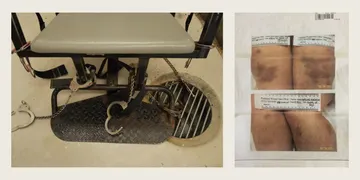In the effort to release people from jails to stem coronavirus outbreaks behind bars, those jailed for probation and parole violations have been an obvious choice. They’re locked up not for committing new crimes but for breaking the rules of their supervision, like drinking alcohol, traveling without permission, or missing appointments. In New York alone, Governor Andrew Cuomo last week ordered the release of more than 1,000 such people from jails around the state.
These efforts spotlight the hundreds of thousands of people who are jailed each year for behavior that would be routine if they weren’t on probation or parole. Research has long called into question the public safety benefits of locking them up, and other traditional probation and parole tactics. Now social distancing orders to slow the virus are providing a way to test some changes critics have advocated. Fifty reform-minded probation and parole chiefs last week called for states and counties to “suspend or severely limit” jailing people for supervision violations that aren’t crimes, among other changes, in response to COVID-19.
One of them was Brian Lovins, president-elect of the American Probation and Parole Association. “This gives us a big opportunity to challenge the need for incarceration for non-violent folks,” he said.
With government buildings closed across the country, check-ins at parole and probation offices are all but suspended nationwide. Many departments are doing drug testing only in the most high-risk cases, according to a small New York University survey and interviews with people in the probation and parole field, known as “community corrections.” And with jails overcrowded and courthouses shuttered, some departments have stopped making arrests for breaking the rules of supervision—known as “technical violations”—unless there’s an imminent safety threat. Some places have formally ordered officers to stop bringing people to jail for technical violations. In others, fewer home visits and check-ins mean fewer opportunities for officers to discover broken rules.
To be sure, dialing back close pre- or post-release supervision is not without risk. Around the country, officers are using video and phone calls to keep in touch with people they supervise, but they lose some nuance and personal connection when they’re no longer in people’s living rooms, observing family dynamics, or visiting workplaces and having informal chats with whoever manages the person there, probation and parole professionals said in interviews.
Susan Rice, the chief probation officer in Miami County, Indiana, sees this time as a “big social experiment.”
“We all think we have to supervise these people and be drug testing them constantly and following them around. If we stop doing that, do they fall apart? Get rearrested? Overdose? Will it really happen or will we see that they’re fine?” she said.
Originally designed as an alternative to incarceration, probation and parole have instead become “a significant contributor to mass incarceration,” according to a 2017 Columbia University Justice Lab statement signed by more than 60 prosecutors and community corrections directors across the country. On any given day, supervision violations account for almost a quarter of people in prison nationwide—about 280,000 people—according to an analysis by the Council of State Governments’ Justice Center.
“This is what the research has been saying: just leave them alone,” says a probation chief in the upper Midwest, who asked not to be named so his staff don’t feel he is criticizing their usual practice. Even before the coronavirus crisis, his office had been trying to implement probation “dosing”—tailoring their support to the person’s risk and needs, as opposed to a one-size-fits-all approach.
“We probably still over-supervise when we don’t even intend to,” he said. With the current suspension, “I think there will be some ‘ahas’ coming out of that.”
Late last month, a Georgia man who’d recently had a double lung transplant was set to serve a year in prison for a probation violation, according to Michael Nail, the state’s commissioner of community supervision. “That’s the last person you want to be going into the prison system” under the threat of COVID-19, Nail said. Nail said he got a call from a local sheriff, who was anxious to have the man out of his jail but couldn’t get the prison system to take him. With a judge’s help, they arranged to have the man released on time served.
“There’s nothing out there that shows a specific amount of time in custody is the magic number” to address violations, Nail said. Coronavirus precautions are “an opportunity to educate folks on what the research shows.”
The pandemic has also suspended some of the social supports that are both lifeline and requirement for many on probation and parole, including Alcoholics Anonymous and Narcotics Anonymous meetings, appointments with counselors and therapy groups. Some of those have been temporarily replaced by telehealth or video conferences. One probation officer in Westchester County, New York, said she spends her days on the phone, scrambling to help people sign up for unemployment or log in to virtual appointments. She asked The Marshall Project to withhold her name because, like several of the officers interviewed, she was not authorized to speak with a reporter.
Meanwhile, probation and parole caseloads are likely to rise in coming weeks as prisons and jails look for ways to reduce overcrowding. This week California Gov. Gavin Newsom announced the state intends to release 3,500 prisoners to parole earlier than planned.
“We’re all kind of freaked out,” said a Missouri probation officer whose caseload is exclusively people with sex-offense convictions. Her state’s pandemic protocol calls for “high and very high risk” clients to be seen face-to-face just once per month; all others check in by phone. “Anyone that’s been around knows they can drug all they want, they can not report, they can abscond, and they’re not going back to prison right now,” she said.
But others say the rules were too strict to begin with.
One man on parole in New York said that when he heard officers were not issuing technical violations, he decided to fly out of state for a night to meet his newborn granddaughter. He asked not to be named because he was discussing a parole violation. He had only been out a few weeks after serving decades in prison, but decided to take the chance because he was afraid that once the usual protocols are back it will be years before he may get a travel pass, he said.
“I'm not going to follow all of their rules and then catch the virus—anything could happen—and then I die and I never met my granddaughter,” he said.
So far, crime appears to be on the decline in some cities, even with a coronavirus-related rollback in nonessential policing, according to an analysis by The Marshall Project. Some of the decline can certainly be attributed to people hunkering down at home and other social distancing steps. But the numbers, although not yet conclusive, may provide reassurance to those who fear that releasing people from jail and easing supervision will lead to more crime.
In Massachusetts, the court has scaled back the number of people placed on electronic monitoring to limit the interpersonal interaction required to have the device fitted as well as non-serious violations that result from the devices, said Edward Dolan, the state’s probation chief. Massachusetts is only putting ankle bracelets on people for whom the state “couldn’t figure out a way not to do it.” This includes those convicted of stalking or domestic violence, Dolan said.
It shows how the coronavirus pandemic is forcing the justice system to “adjust its risk threshold,” Dolan said.
“It’s really a balancing between the impact of the pandemic, and what we’re willing to collectively tolerate as risk in the community.”

